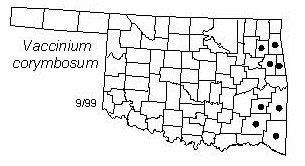Shrub to 4 m (12 ft) tall, forming dense colonies. Twigs slender, warty and yellow-green, glabrous. Leaves alternate, simple, narrow to broadly elliptic or ovate, 3.8-8.2 cm (1.5-3.2 in) long and 0.8-1.9 cm (0.3-0.8 in) wide, at least pubescent on the veins beneath, glaucous to very glaucous above; acuminate to acute at apex, margins entire and ciliate to serrate. Flowers 8-10 in a corymb, 6-12 mm (1/4-1/2 in) long, urceolate; calyx 5-lobed, glabrous or glaucous, acute; petals 5 short lobes; styles 1; stamens 8-10; flowers appear from May to June, when leaves are half emerged. Fruits berries, 5-12 mm (1/5-1/2 in) in diameter, subglobose, blue; many-seeded; fruits mature June to August.
Distribution: Okahoma, Arkansas, Louisana, east to Florida, north to Nova Scotia, west to Ontario and Indiana. Uncommon in the Ozark and Ouachita Mountains.
Habitat: moist soils, floodplains, sheltered slopes and ravines.
NWI status: FACW-.FACW
Comment: Vaccinium is the classical name for blueberries; corymbosum refers to the inflorescence type.
Horticulture: propagates by root suckers and transplants well.
Wildlife benefits: Fruits are eaten by several species of birds.
Distribution in Oklahoma: 
BACK
NEXT
RETURN TO INDEX
Last update: 9/22/99
 Go to Oklahoma Biological Survey Home Page
Go to Oklahoma Biological Survey Home Page
 Disclaimer
Disclaimer